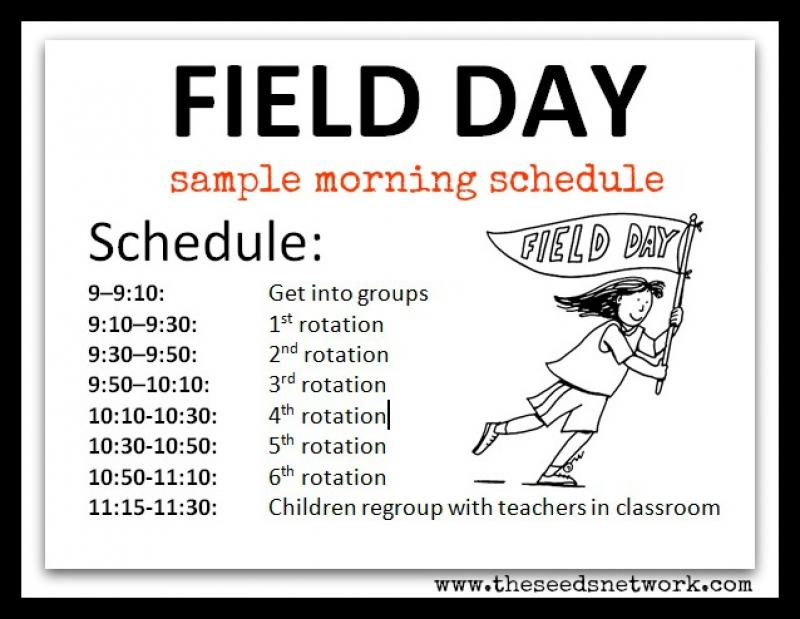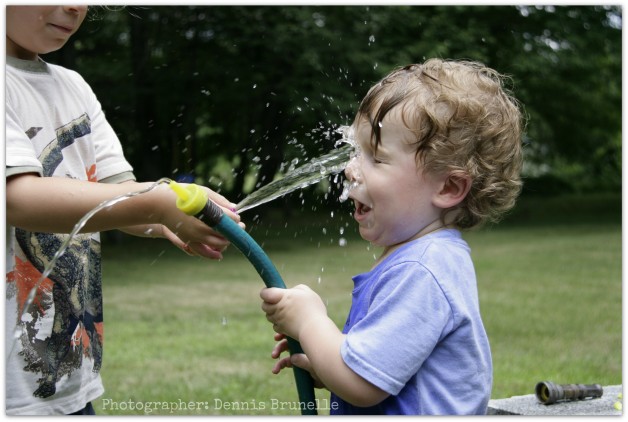At the end of our school year for the past few years, our preschool has a Field Day where the children rotate through a variety of gross motor activities and spend most of the morning outside playing and working together. It is a great day, but definitely requires planning to make sure it goes smoothly.

This is definitely different than a Field Day for older elementary school children … you need to factor in preschoolers attention span and make sure activities are developmentally appropriate, and allow for all children to be successful and to have fun.
We put together some of our tips for planning a successful Preschool Field Day, and have some planning sheets that you can print off and use as well.
TIP #1: COMMUNICATE WITH PARENTS
We put information about Field Day in our school newsletter a few weeks before the event. (See a sample flyer). We let families know about how the morning will go, that their child will be spending a good portion of their morning outdoors (so they need to apply sunscreen before dropping off their child), and we ask for some parent volunteers and healthy snack donations.
TIP #2: PLAN A RAINDATE
Yes, you could plan an indoor Field Day alternative … but really, do you want to? Part of the real joy of Field Day is being outside for a good part of the time – so if you are able to, plan to have a raindate option in advance.
TIP #3: PLAN TO HAVE EXTRA STAFF
This is an “all hands on deck” type of morning – and we never have any trouble getting some of our afternoon staff to sign up to come for the morning because the day is so much fun! Allow for extra staff members to be floaters, help with bathroom trips, getting extra water, etc. I’ll explain how we break out our staff into various roles in my next post.
TIP #4: KEEP THE SCHEDULE MOVING
We schedule each rotation to last no longer than 20 minutes and keep the kids moving. We keep in mind the attention span of preschoolers for any given activity – and 20 minutes is more than enough time to play each game/activity and then get to the next station. (See a sample schedule below).

TIP #5: ALLOW FOR A FREE PLAY PERIOD
In our schedule, one of our rotations is free play in the playscape area. They need some free time to take a rest, swing on a swing or socialize with their friends.
TIP #6: MAKE SURE YOU SCHEDULE A SNACK BREAK
The length of the morning will definitely cross into your snack time. We make “snack” one of our rotations, and we ask parents to bring in some healthy snack items, such as fruit, crackers and cheese. *Allergy Alert* – be sure that whoever is in charge of the snack area is aware of any food allergies.
TIP #7: HAVE WATER AT EVERY STATION
Rather than having to make frequent trips to the water fountain, bring pitchers and cups outside to each station so that children are free to get some water anytime they need it.
TIP #8: BE FLEXIBLE
You know what they say about the best laid plans … and when you put 3-5 year old children into the mix, you need to allow for some flexibility. Some children may not want to participate in each activity for various reasons (ie. tiredness, need a break) – which is another reason why it is key to have some extra staff on hand to help out. Don’t force each child to participate, but encourage and modify any activity in ways that allow all children to be successful.
SUGGESTION FOR GROUPING CHILDREN:
What we have done and found to work well at our school is to create mixed age groups of children (3-5 years). Teachers assign children from their classes into teams – and we mix up the classes so the children are on a team with some of their classmates, but also get to meet and work with children from the other classes. This has helped to promote teamwork and less competitiveness, and children get to play with some new friends!
ACTIVITY STATION IDEAS:
Need ideas for some gross motor and cooperative games? Go see some ideas at Team Games and Gross Motor Games
ASSIGNING TEACHERS AND STAFF ROLES:
For specifics about assigning teachers and staff into roles, check out Field Day: Part 2!




Leave a Reply